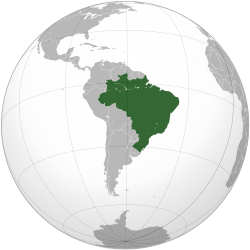Second Brazilian Republic
| United States of Brazil | ||||||||||
| Estados Unidos do Brasil | ||||||||||
| Multi-party Republic | ||||||||||
|
||||||||||
|
||||||||||
|
Motto "Ordem e Progresso" (English: "Order and Progress") |
||||||||||
|
Anthem Hino Nacional Brasileiro (English: "Brazilian National Anthem") |
||||||||||
| Capital | Rio de Janeiro (until 1960) Brasília (after 1960) |
|||||||||
| Languages | Portuguese | |||||||||
| Government |
Multi-party Republic • Presidential (1946–61, 1963–64) • Parliamentary (1961–63) |
|||||||||
| President | ||||||||||
| • | 1946–1951 | Eurico Gaspar Dutra (first) | ||||||||
| • | 1961–1964 | João Goulart (last) | ||||||||
| Prime Minister | ||||||||||
| • | 1961-1962 | Tancredo Neves (first) | ||||||||
| • | 1962-1963 | Hermes Lima (last) | ||||||||
| Legislature | National Congress | |||||||||
| • | Upper house | Senate | ||||||||
| • | Lower house | Chamber of Deputies | ||||||||
| Historical era | Cold War | |||||||||
| • | Dutra's ascension | 31 January 1946 | ||||||||
| • | Adoption of new Democratic Constitution | 18 September 1946 | ||||||||
| • | Change of Capital to Brasília | 21 April 1960 | ||||||||
| • | Parliamentarist Government | 8 September 1961 | ||||||||
| • | Return to Presidentialism | 24 January 1963 | ||||||||
| • | Military Coup d'État | 31 March 1964 1964 | ||||||||
| Area | ||||||||||
| • | 1903 | 8,515,767 km² (3,287,956 sq mi) | ||||||||
| Population | ||||||||||
| • | 1950 est. | 51 944 397 | ||||||||
| • | 1960 est. | 70 992 343 | ||||||||
| Currency | Cruzeiro | |||||||||
|
||||||||||
Second Brazilian Republic is the period of Brazilian history between 1946 and 1964 also known as the "Republic of 46". It was marked by political instability and military's pressure on civilian politicians which ended with the 1964 Brazilian coup d'état and establishment of Brazilian military government.
This period was marked by often tumultuous Presidencies of Eurico Gaspar Dutra, Getúlio Vargas, Juscelino Kubitschek, Jânio Quadros and João Goulart.
In 1945, President Getúlio Vargas was deposed by a bloodless military coup, but his influence in Brazilian politics remained until the end of the Second Republic. During this period, three parties dominated national politics. Two of them were pro-Vargas — the Brazilian Labour Party (Partido Trabalhista Brasileiro, PTB) to the left and the Social Democratic Party (Partido social Democrático, PSD) in the center — and another anti-Vargas, the rightist National Democratic Union (União Democrática Nacional, UDN).
As World War II ended with Brazil participating on the Allied side, President Getúlio Vargas moved to liberalize his own fascist-influenced Estado Novo regime. Vargas decreed an amnesty to political prisoners, including the chief of the Communist Party, Luís Carlos Prestes.
He also introduced an electoral law and allowed political parties to campaign. Three political parties introduced themselves into the national political scene. The liberal and rightist parties of the opposition against Vargas created the National Democratic Union. The bureaucrats and supporters of the Estado Novo grouped in the Brazilian Social Democratic Party. Vargas also created the Brazilian Labour Party, to the left, to group the workers' and the laborers' unions. The Brazilian Communist Party, weakened during the dictatorship, was also legalised.
...
Wikipedia



